

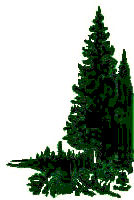
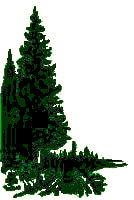
Black Duck Lake
Written by "Bill" Pankoski When I was asked to write the history of the Black Duck Lake area, it didn't seem such a large assignment, even though I was asked to put as many names of the people who lived there as possible. I thought there wouldn't be that man! Then I realized I had lived there for fifty years, more or less, and the number of people coming and going, staying and leaving; those who struggled and survived, those who struggled and didn't survive, those who struggled and gave up and those who just gave up, add up to quite a few names. I beg forgiveness in advance for the people I may have missed. My father, later known as Pop Craddock, to all and sundry, moved to the Big River district in the early summer of 1921 from the Wood Mountain area in south-western Saskatchewan. Pop left because of the increase of settlers moving into the rolling ranch land and he felt a bit crowded around the elbows. He sold his store and headed north with three wagons and about sixty head of horses. He was accompanied by Floyde Cave and his wife Muriel and their small daughter Francis, also Shorty Raymond who had come west from Quebec and who worked for my father. How many weeks of gruelling travel and how many things went wrong is forgotten. Dad and Shorty herded the horses on horseback and Floyde and his wife took turns driving the teams. It was June when they arrived in Big River and how they made their way to a point fifteen miles north of the town, I don't recall as there was no real road at that time. The terrible fire of 1919 had destroyed the standing forest of jackpine. These fallen monarchs now lay charred and dead in every direction. It was said a person could walk from one side of the country to the other on these logs without setting a foot on the ground. Being charred, it took many years for them to rot and I don't think the roots, left in the ground ever did, for many a dreamy plowman sailed into the Great Blue Yonder when his plough struck one of these buried roots. The boundary of the Black Duck area begins approximately four miles north of Big River and ends near Rat Lake or Taggart Lake. It is bounded on the west by Cowan Lake and on the east by Egg Lake meadows. Dad set to work building a log house about thirty by forty feet, using fallen logs hauled out of the bush. The logs were chinked with local moss, but before spring most of the moss had fallen out leaving the daylight to filter through. Nevertheless, the house was always warm in winter and cool in summer. In later years, it was an annual fall job to "slosh" mud over the outside of the house before freeze-up; this kept the wind and snow from whistling through the open cracks. The roof was made of poles which were covered with loose dirt and hay. This provided warmth, but very little protection from the rain. When things were more or less lined up, Dad returned to Wood Mountain and shipped seventy or eighty head of cattle to Big River by rail. He and my nine year old brother Lynne, made the return trip by train as well. My mother and I came to Big River in the winter when everything was ready for us. It was in December, 1921, when we arrived on a dark cloudy miserable evening. Dad wasn't able to meet the train so he had arranged for a neighbour, Charlie Wakefield, to meet us and take us to Grannie McKnight's boarding house. It was situated on the lot where the theatre now stands. Grannie was a widow and a wonderful character; she was kindly and alert and never at a loss for words. The night we landed there, the boarding house was filled so we were taken next door to her daughter and son-in-law's place, Mr. and Mrs. Harry Gilbert, and we spent the night there. (This is the present home of Mr. and Mrs. J.K. Johnson.) My memories of the first few years are sketchy and hazy. I know my mother became expert at cooking bush rabbits, prairie chickens and other native creatures. She served rabbit stew to many chance callers and received great compliments on how well she cooked chicken! By spring of 1922, only about three of our horses and as many head of cattle had survived the change of feed and climate. From then on, we were so poor the depression of the thirties would have passed unnoticed had it not been for the added aggravation of the drought. There were few other settlers at that time - more seemed to be moving out than in. There were the Slighs and the Derksons, who lived on the hills in the Black Duck Meadows. There was one chap I never met, but his name appealed to me. He was known as Bugwhiskers. I think his name was Wahl; he lived on the northern end of Black Duck Lake, land later owned by Albert Guillmette. The Wakefields were there for a short while after we arrived. There was Charlie and his brother Ted, Ted's wife and small son Billy. Ted and his family lived a mile or two north of Charlie's farm which was situated across the strait from what was called the Big Island. Charlie and Howard Deckster and Dennis Erskine lived on the farm, known as The Estate. Dennis later married Alida Brownfield and they moved to England, Dennis' homeland. The Wakefield brothers came after the first war and settled on a tract of land under the Soldier Settlement. Ted later moved to town and clerked in Brownfield's store. Years later both Charlie and Ted moved East. We had two other neighbours, one was Edward LaRock who lived about two miles north of Us. He had come from Minnesota, and the other was Jack Miller who was also from the States, but must have come from Scotland originally as he had a strong Scottish accent. He had a cheerful freckled face, red hair, and a gift for spinning comical yarns. Pete Arsenault was our neighbour to the south. We all lived along the shores of Cowan Lake, which was our source of water and way of travel. Pete was a native of New Brunswick. He did like the rest of us - ran a few head of cattle, a few horses, trapped a little and ran a stopping place for the casual traveller. In the early days, all winter travel was done with horses. They hauled freight into the north and fish out of the north to the railway in Big River. It was quite a large industry, and because of the cold, the horses had to be under cover during the night. The poor things would come in struggling with big loads over the frozen snow, they would be white with frost, icicles hanging from their noses, some with running sores on their shoulders from chafing collars. The suffering borne by some of the horses in those days must be remembered. They bore hunger, cold, beatings, and abuse at times and many died on the roads. It was a great relief to animal lovers when tractors and later, trucks took over the hauling. Horse travel was necessarily slow. A trip from Big River to Green Lake was a three or four day stint. Leaving town, the first stop was thirteen miles out at Pete Arsenault's, our place was next and then Camp B and Camp 2 and Camp 4. These camps were remnants of the earlier logging days and remaining buildings had been converted into stopping places. Providing food and lodging for the travellers and meeting so many people was an entertainment in itself. We made many good friends and saw many funny sights. Very few of the stopping places had bunks or beds, the people just brought their bed rolls and rolled them out on the floor and crawled in. There were a great many Indians in those days who travelled to and fro with horses or dog teams. One group that I remember decided to do their own cooking at our place. A black char mark on the wooden floor where they had set their hot frying pan was a memento that lasted for many years in spite of my mother's scrubbings. Most of the travellers opted for home cooked meals and I now marvel at the amount of cooking my mother must have done. We always grew a large garden. In winter we usually had beef; in summer it was usually bologna or fish. With no electricity and no deep freezers, we had to resort to putting what we wanted to keep cool into a pail and dangling it down the well. It was quite an experience to see those tired, hungry, wind-burned men demolish mountains of food in such a short time. Their only breach of etiquette that I envied, but didn't dare copy, was their dexterity at eating with a knife. The standard price for a meal was forty cents and the price of a large homemade bread was ten cents. That was another source of revenue and mother punched a hundred pounds or more of flour into her large crusty brown loaves every month. I remember my parents wanting to buy a camp stove from someone who was moving away. The price was six dollars. They wanted the stove for the hay camp, as mother was getting tired of cooking over an open campfire, rain or shine for a gang of hungry haymakers. They were a couple of dollars short of the six so I had to produce my bank, a wooden snowman. It had no natural outlet, so it had to be shaken until the odd nickel and dime that had been accumulated rattled loose. All the shaking in the world didn't bring up the two dollars required and mother had to sell ten large loaves of bread to finally make up enough for the precious camp stove. 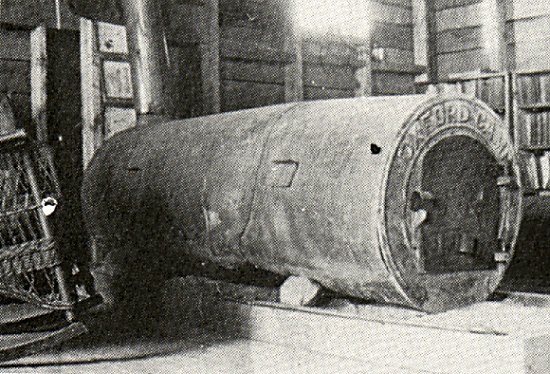
Camp stove.
It was those formative years that I first met Mr. Tom Borthwick. He freighted from Big River to Camp 4 with an old boat covered with canvas. A team from Green Lake would meet him and take the freight and he would return to Big River for another load. On this particular day, mother and I were alone in the house when I heard something at the front door. We had a front door for some reason, but because of the swelling of the wood or the sagging of something, it was more trouble than it was worth to open. However, we must have been enjoying a spell of dry weather, for when I swung the door open to see what the noise might be, there stood a big man. I was likely around four or five years of age at the time. I slammed the door in the poor man's face and gave out a yell, "Mummy, it's a man!" My mother went back to the door to try and undo my social "faux pas", opened the door and Mr. Borthwick glanced past her at the huge camp heater resting on its box of dirt behind her and said, "My God woman, what a stove!" We became well acquainted with Tom through the years. He often stopped in and I became quite a favourite with him. He would always bring me a treat - a bag of bananas, reasoning likely that they were better for me than candy, in that, he was probably right as I hated bananas and never ate them. I once met his wife, who was a native, but though I only once, there was something so warm and nice about her that she absolutely fascinated me. We also met their daughter and her husband who was at that time, a provincial policeman at Green Lake. When Tom's old boat finally gave up the ghost, he got Dad to build him a larger one. He travelled many, Many miles up and down the lake. Both Tom and his wife are buried in the Big River cemetery. All summer travel and freight hauling had to be done on the water in those days. There was no road past the settlements along the lake and the old Green lake Road on the west side of Cowan Lake left much to be desired. The merchants and trappers of the north would come down the rivers from places like Ile-a-la-Crosse, Beauval, and La Plonge, have a little spree in Big River, then build freight scows down by the lake. Several scows would be under construction at one time. I watched with interest when I was told the caulking on the cracks of these scows was done with tallow. This would set hard and keep the water out, well, some of it anyhow, until they reached their destination and they were dismantled and the lumber used again. To keep the tallow soft enough to spread, the caulker filled his mouth with hard tallow and when it got warm it softened enough to spread, thus his mouth was used like a point pot. When the scows were ready and loaded, they travelled to Cowan Dam, which was approximately thirty-two miles from Big River. The dam had been constructed in the mill days to raise the water level to float the logs cut in the winter in various camps along the lake and dumped on the ice. They were later towed with the old paddle-wheelers to Big River for sawing during the summer. The odd thing about the river trip was that the dam keeper had to open the gates about two days before the scows went through to raise the water high enough to float the loaded vessels, but even then the scows caught up to the water before they could proceed. In later years, when there was a drought and water shortage, the scows were only allowed certain days for travel. When we lived in the area, Mr. Phillip Kelly was dam keeper. He was an Irishman and his good wife Matilda was a highly cultured coloured lady from Jamaica. Later Bill Mahoney, who had been a school teacher in Big River in his younger days, had the job and later Ivery Newton became dam keeper. There was a succession of keepers and a succession of dams, but when the last timber dam burned out and the dam keeper biffy burned too, a cement dam was built and the gates locked. The dam was only used for controlling the water level and to allow the fish upriver for spawning, for there were roads by then and little or no water travel. 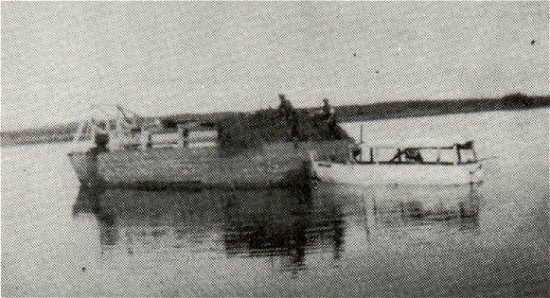
Scow.
During these years my father was certainly not idle. During off seasons, he turned his hand to anything available. He did carpentry, veterinary work, built several fireplaces in the cottages at Ladder lake and was an expert sign painter. Many a sack of flour he lugged home for his credit for store signs. He could fix everything and make anything. It must have been very hard for mother, raising two children and being alone for weeks at a time. Dad usually got home weekends, by boat in summer, and in the fall and winter, he would often skate home the fifteen miles, even resorting to a small sail on his back when the wind and he were going in the same direction. He helped build the Lakeview Hotel and did many other jobs that were available. He often had to walk in the early days and I remember two instances. One was when he had gone to town on the ice in the fall just after freeze-up. He pulled a hand sleigh to bring groceries home. The weather turned bad and late the next afternoon, my brother and I decided to go see if Dad was coming. We met him a mile or so from home, pulling the sleigh through slush and snow. He was eating brown sugar as he walked, as he had no lunch with him. We took over pulling of the sleigh and Dad said walking was so easy now he felt like someone was pushing him. The other instance was brought on by my brother's passion for music. He had trapped enough muskrats to be able to send to Eatons for a guitar and had to endure the usual wait as we didn't have any mail delivery. One day in winter, Dad walked to town and when he came back the next day, he had a large carton strapped to his back. He hadn't taken the instrument out of the case as he knew the thrill of opening it would mean a lot to Lynne. It was lucky we were reasonably healthy for there was very little transportation, no telephones, and often no doctor if we did get to town. I did have one scare. I stuck my finger into the small hole in the blacksmith's anvil and couldn't pull it out. A frantic yell brought mother to the scene. My brother was dancing around telling me I'd likely carry the anvil around on my finger for the rest of my life; as the thing weighed one hundred and fifty pounds, my future looked pretty bleak. Mother calmly kept ice cold water over my hand until the finger shrunk and came free. I felt as if I'd just won the crown jewels! Like other women of the time, my mother must have been ready to climb the wall many times, only the expression hadn't been coined in those days. Left alone with the children while husbands went away to try to earn a few dollars could not have been a vocation of choice. One person who must be mentioned is Joe Nicholson. He played rather a large part in our life then, as he was a forest ranger at the time and dropped in at any hour of the day or night and left the same way. He always walked but was accompanied by a saddled sorrel horse called Shorty. I never saw him in the saddle and I don't see that Shorty could have been much company, for he followed about twelve lengths behind Joe. Joe was a most colourful sort of person, originally from Stornoway, a town in the Outer Hebrides of Scotland. His wife is said to have been one of the ladies-in-waiting to Queen Victoria Joe enjoyed life and put a lot into it. He was a veteran of the Boer War and the First World War. The stories he could tell, always with a comical twist, of his adventures would fill another book. He had a homestead on the south end of Black Duck lake. Nearby was another veteran, Ernie Over, who later was employed by the Forestry. Jesse Leverton now lives on the old Nicholson place. Joe loved to sit by the fire telling stories. He used to roll his own cigarettes and light them with the old wooden matches. I used to sit and watch - he would roll his smoke, then light a match - all in the middle of a yarn. The match would burn down to his fingers as he talked and he would toss it into the dirt box around the heater and light another. It took at least three matches for each cigarette before he would finish his story and light up. Joe told about the time he fell out of the wagon and the iron wheel went over his head. He said he was indestructable, but the wheel was never the same. During the mid 1920s, there was an influx of settlers from Germany. They took up land six or eight miles north of town, just west of Black Duck Lake. They were mostly city people, just out from the old country with little idea of how to farm, however, they did like everyone else, worked their land in farming season and took any job that offered itself the rest of the year. There were the Eismans, Max and his wife and two sons, Horst and Fred, Mr. and Mrs. Runge and their children, Frank Jr. and Ursula. Frank Jr. married Ruth Anderson, one of George Anderson's daughters and they now live in Vernon, B.C. Ursula married Jim Dawson. There was also Mr. and Mrs. Joe Billinger and son Fred, and Mr. and Mrs. John Grimmler and son Heinz, and the Feldmier boys, Hans and Carl. With the drought and depression of the thirties there came another wave of people, encouraged by the government to flee the dried out prairie. Some came and looked and moved on, others came and stayed for a while and then moved away. Some came and stayed. Some of those who stayed were Pete Pasternak, his wife and daughter Olga; Charlie D'lugon and Alex Pankoski. They came from the south bringing their livestock with them in the hope of finding greener pastures. Another settler was Joe Urasavick. He finally settled at Dore Lake. His sad life story was recorded in McLeans Magazine and a film was made of his wife's trip to Canada and her short life here. Alex Pankoskie bought Pete Arsenault's place when Pete went north, choosing trapping as his vocation. We had many visits from the clergy of the day. Father Lajueuness, who was the Catholic priest, was a frequent visitor. Students from the United Church sometimes came for the weekend when Dad would invite them along. Gordon Phillips was the minister at the Anglican Church for some years and used to ride out occasionally with his horse hitched to a toboggan and bring us all the latest news. The Sunday School Van ladies made our place home from very early days, what those city girls must have thought of our mode of facilities - or the lack of them - must have been something else. Charlie McKenzie and his family came in the thirties and lived in several places around the area. Charlie was a hard worker and always gave a hand here and there. They had a number of children who adopted our family, and Dad and Mother delighted in making them toys and dolls at Christmas time. Charlie tried everything to make a dollar in those difficult years, even to picking wild strawberries which he sold in town, taking them in by canoe. One day when the wind was favourable, he raised a sail on the canoe. A pull of wind struck him as he entered the Narrows near Big River and into the water went Charlie, berries and all. There were many trappers in the district, several trapped around Rat Lake district; they walked to town in winter for supplies and often stayed over with us. One was known for a long time as Ginger Beard because of the bright red beard that covered his face in the winter. He was Holger He was Holger Peterson. His nephew, Otto, also spent some time on the same trap line, as did Chris Thimson. These boys were all Danish, not long out from Denmark. Chris worked on farms after he first arrived and learned to speak English. He later, like many others, moved north and his history is written by one of the Karras brothers, who moved into the vacated Rat Lake trapper's cabin and later wrote a book, North to Cree Lake. Near the south west tip of Black Duck Lake, lived one of the settlers who came during the twenties and established himself by hard work. This was Theodore Wychodzew. He had escaped from Russia into Germany during the revolution of 1917. He and his wife lived in the Black Duck area for many years before moving into town. Mrs. Wychodzew's brother, Max Beggar, lived with them for a time. In the same area was another settler, Frank Lorenz, who moved there from Shellbrook. Mrs. Lorenz told how her father had moved to Canada; he walked from Oklahoma to Shellbrook, liked what he saw and walked back to Oklahoma to move his family north. Just west of the Lorenz farm was the Daley - Pliney farm. Jack and Mrs. Pliney lived there. She was the mother of the Daley boys. She was a friend to everyone and everyone's friend. Nearer the lake lived Leo Griepl and his wife, Virgie, and daughter, Tess. Tess later married Steve Mysko and lived on the Runge farm. On the north end of Black Duck Lake, lived Albert Guillmette and not far away was his half brother, Rene, and his wife and family. Both men were from Quebec. Then there was George Mortz, who came in later years. he and his wife lived and worked around the district. I think George lost his liking for the country the day he accidently got between a mother bear and her two cubs. He was walking along and saw the two cubs playing - Mamma was nowhere in sight. One of the cubs hit the other and it let out a yell of rage, Mamma hearing this, thought George was harming her young ones and arrived on the scene in short order. George was between the mother and the cubs and had no choice but to cross a fifty foot pool to get away. He said that he went right through the middle of the pool and arriving home he found his feet weren't even wet! Jesse Leverton moved here from Debden in the thirties. He arrived at our place during a horrible snowstorm, one of those storms that made the road impassible. We asked Jesse and his party in but they refused and took refuge in an old bunk shack out in the yard. Next day they drove to Hall's Lake, a lake in a string of meadows and lakes north of Egg lake and joined by a creek from the Black duck Meadows. I think Hall's Lake got its name from Harry Hall, who once made history by paddling his canoe from Ladder lake, through the meadows and into Hall's Lake. I believe Hall's Bay on Delaronde Lake was also named in his honour. Jesse Leverton lived on Hall's lake for some years then moved to the Nicholson property after Joe had moved to town. Adolph Miller and his family came from the south during the dry years and lived at various places. Johnny Markowski was another who came in for a few years. Joe Malinowski was another who blew in from the dust bowl. He trapped at Poplar Point and raised mink and fox. He joined the army and spent some time overseas as a Jeep Doctor in England. As for the Pankoski family, I don't think we make much history with our humdrum doings. We tried just about everything. We had cattle, horses, sheep, goats, pigs, rabbits, mink, dogs, cats, etc., we even had a couple of children but the government subsidy was so low on them in those days, it wasn't a paying proposition. We kept them and loved them and fed them somehow. There was not only depression, but the drought that kept up into the forties in our area. I remember my husband sitting up on the roof one day pulling handfuls of shattered shingles off and tossing them down. "I don't know how come this roof doesn't leak," he remarked. "How in the world could it," I replied, "It hasn't rained for two years." There was the Benoit family who acquired the Wakefield property. Mr. Benoit was a retired gentleman from Saskatoon. They had three sons and a daughter. The eldest son, Eddie, stayed on the farm when the rest of the family moved back to the city for the winter. Mr. and Mrs. Joe Stuesser and son, Arno, bought the Eisman place. They were a good family who enjoyed friends and neighbours. Others who played a part in local development were Jim Brooker and his wife Margaret. They trapped in the Rat lake area. Mrs. Brooker was a notable artist and had many lovely scenic paintings. Jim took a job with the D,N.R. as forest ranger. They later moved to Salmon Arm, B.C. Close to Brookers, lived two other homesteaders, Charlie Johnson and Pete Thibeault. Charlie's land was later owned by George Campbell, while his cousin, Bill Lowe purchased Brooker's land. George and Bill worked together raising cattle and were both great horse lovers. Mary Campbell, George's wife, had a body of a sparrow, a heart as large as an elephant, and the spirit of all get out. She suffered a great deal of illness but it never warped her tremendous love of life and sense of humour. They were the best neighbours we ever had and would bend over backwards to do a favour. I can remember Frank Schloegel Sr. and Jr., Tom and Jane Robinson, who came up from Ontario. There was Frank Johnson and Peter Person, partners, who moved onto our original site when we moved a mile south in 1929. In the early days, parties were much different than they are now. We lived fifteen miles from town and quite often in winter a group would rent a team and driver and load up a whole gang of people and drive out to our place. They always brought their food along and it was one of those times I tasted my first wiener - how good it was! Some of the folks who came out were: Jack McLeod, the station agent and his wife Nancy, Mr. and Mrs. Horncastle, also Mr. W. Turple, and his wife Olga, who was Mr. Mahoney's daughter. There was Joe Friedman and his brother Rueban and their current girl friends. One of the girls was Pearl Wrixon, a local school teacher. There was Kathy Waite, Len and Martha Waite, Grace Motherwell and Bill Gould and Fred Buckley. I don't remember what they did for amusement, but there always seemed to be a lot of talking and laughing. 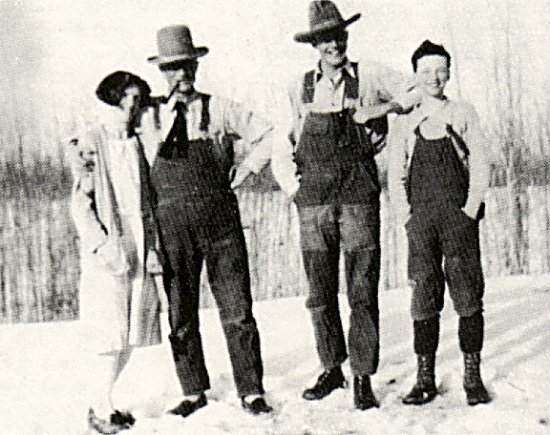
The Craddock family.
There was tragedy too. Joe Lamothe was drowned in an accident; travelling on the lake before the ice was safe enough. It was to our place they brought his wife and two small boys when she set out to look for him. Then there was the time Olga Pasternak got lost on her trapline and it was some of our family who set out to find her and bring her in, her feet badly frozen. Also, there was the time young Joe Aubert accidently shot part of his arm off. It was Dad and Lynne who paddled a heavy boat all one night to get him to the doctor. 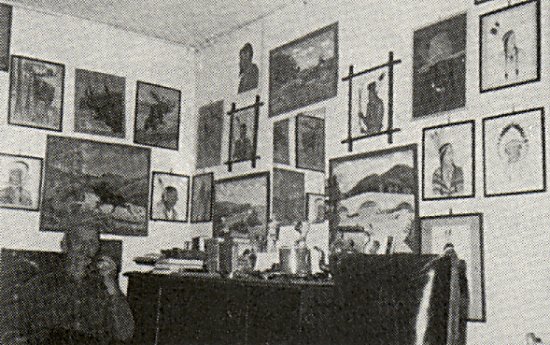
Pop Craddock and his display of pictures.
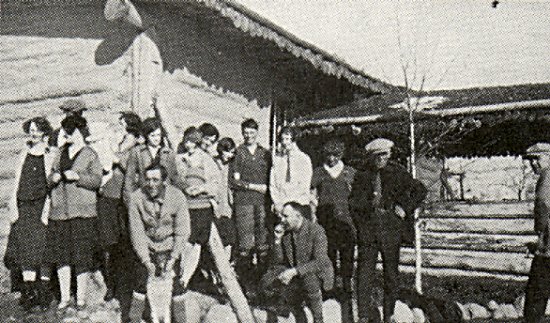
When good friends got together.
There is much drama in everyday life, fortunately it is mixed with comedy which is what pulls us through the good times and bad. Most important, however, are the people - they are the same no matter how you look at it. From the modern crystal ball or an early camp fire, it is the people of a settlement who really count and shape the history. 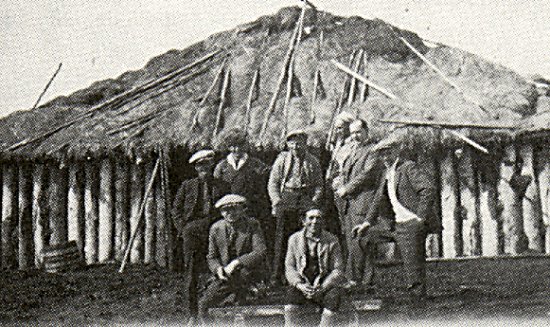
A settler's barn, with a group of Big River residents.
|
| Deep River Fur Farm |
| Deep River Trapping Page |
| Deep River Fishing Page |
| My Norwegian Roots |
| Early Mink People Canada - Bowness |
| The Manager's Tale - Hugh Ross |
| Sakitawak Bi-Centennial - 200 Yrs. |
| Lost Land of the Caribou - Ed Theriau |
| The History of Buffalo Narrows |
| Hugh (Lefty) McLeod, Bush Pilot |
| George Greening, Bush Pilot |
| Timber Trails - History of Big River |
| Joe Anstett, Trapper |
| Bill Windrum, Bush Pilot |
| Face the North Wind - Art Karas |
| North to Cree Lake - Art Karas |
| Look at the Past - History Dore Lake |
| George Abbott Family History |
| These Are The Prairies |
| William A. A. Jay, Trapper |
| John Hedlund, Trapper |
| Deep River Photo Gallery |
| Cyril Mahoney, Trapper |
| Saskatchewan Pictorial History |
| Who's Who in furs - 1956 |
| Century in the Making - Big River |
| Wings Beyond Road's End |
| The Northern Trapper, 1923 |
| My Various Links Page |
| Ron Clancy, Author |
| Roman Catholic Church - 1849 |
| Frontier Characters - Ron Clancy |
| Northern Trader - Ron Clancy |
| Various Deep River Videos |
| How the Indians Used the Birch |
| Mink and Fish - Buffalo Narrows |
| Gold and Other Stories - Richards |
